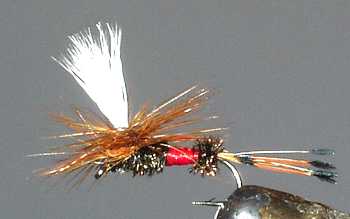The Royal Coachman Parachute Dry Fly
The Royal Coachman is an American pattern that is the gaudy cousin of the British Coachman. When the Coachman wet fly crossed the Atlantic Theodore Gordon adapted it to a dry fly.

PARACHUTE EMERGER DRY FLIES. Hook size 12 14 16 18 20 24 - $US each
In 1876 John Hailey, a professional fly-dresser living in New York, added the red silk band to create the distinctive feature of all Royal patterns. He had been asked to tie some extra strong Coachmen Dry flies. He tied a band of red silk in the middle to prevent the peacock bodies from fraying out. He had also added a tail of barred wood duck feathers. His dry fly has spawned a whole range of variants including streamers and hairwings. Mr L.C.Orvis gave it it's name whilst discussing with others what it should be called. He said "Oh, that is easy enough: call it the Royal Coachman. It is so finely dressed".
Although the wings may vary, all have the same red central body section, butted either end with peacock herl. It often works when nothing else will. The Royal coachman is an excellent general purpose up-winged dry fly that can be used to represent many other large winged insects as well as may flies. It is an ideal wasp, hornet or bee pattern. Treat with floatant and fish it on the surface. Try the occasional retrieve over the surface for a short distance or else twitch it to represent a struggling terrestrial insect like a wasp or bee trapped in the surface film.
The term parachute fly is given to flies in which the hackle is tied round a projection affixed to the top of the hook shank near the eye so that the hackle lies horizontally across the hook which it covers in the manner of an open umbrella. The weight of the hook underneath the circular hackle balances the fly which falls lightly on the water parachute fashion. Various patterns are tied in the parachute style and a Scottish tackle firm was the first to commercially market these flies a long time ago. It is not certain who invented them but an American called William Brush of Detroit applied for an American patent for the idea in 1931 and it was granted in 1934. The patent related to the projection on the hook and not the fly itself.
The traditional way of dressing dry flies with upright wings and hackles that make the fly stand high on the water's surface may be very pleasing but it is not necessarily the best design for catching fish in some anglers opinions. The parachute dry fly style of dressing allows the fly to sit well down in or on the surface film, mimicking either an emerging mayfly dun filling its wings, a spent spinner, stillborn, floating nymph or a crippled drowning fly trapped in the surface film. They can be dramatically more effective at getting takes. Some traditionalist will not use them but I find them very effective and easy to cast correctly. I have found them more suited to still water fishing as once a ripple or two has broken over them they become waterlogged. The softer landing, the delicate presentation is one of this patterns principle benefits. The parachute effect of the hackle slows down the descent. It does not spook the fish as much as a normal dry fly. They are one of my favorite lake flies. When the trout are rising and taking food with a gentle sipping action these are the flies to use.
When the mayflies have stopped emerging and the surface action has died down. The fishing is not over if you know where to look. Go for a walk down the riverbank and look for bankside eddies, areas of slow slack pockets of water near faster moving water. A lot of mayflies do not successfully emerge during the hatch. They are referred to as cripples or stillborn. Others are flipped over, capsized in choppy water. They seem to collect in these eddies. You will find trout rising to them long after the original hatch has finished. Cast a Parachute into these pockets and let it drift. It is a great way to extend your surface fishing time.
Fly Fishing books

